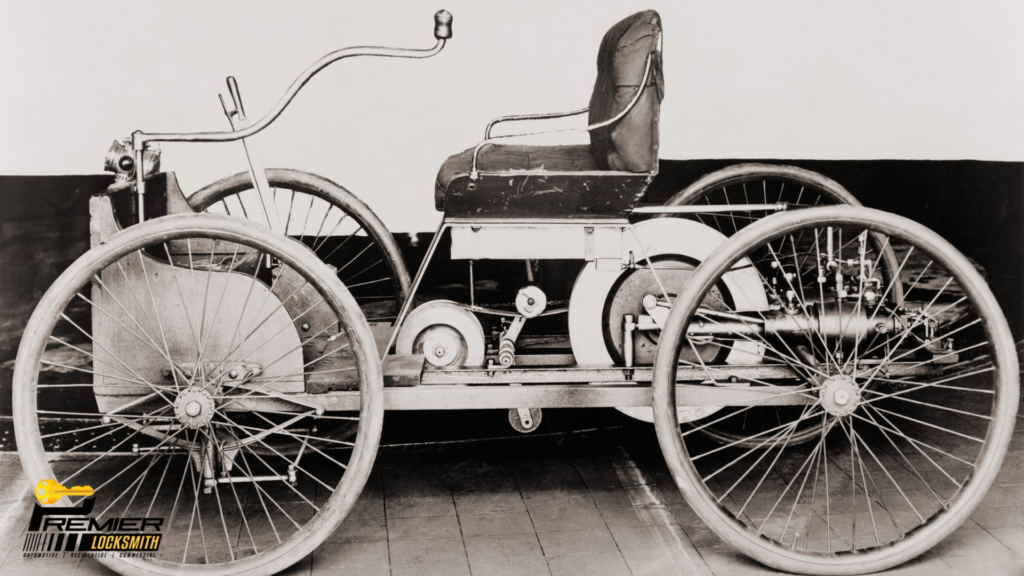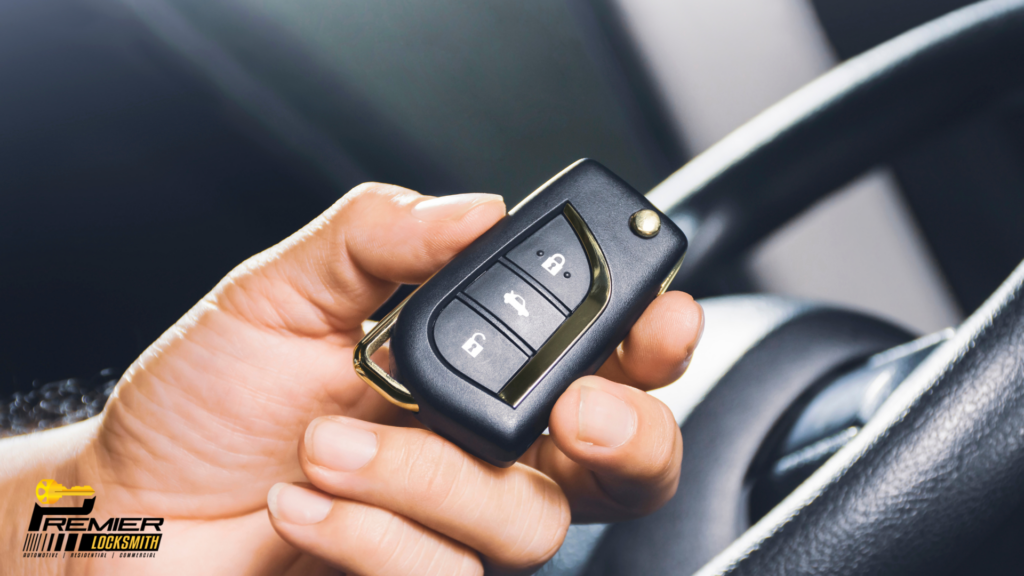Introduction
As a locksmith with decades of experience in the field, I’ve seen my fair share of car lockouts. From simple key mishaps to complex electronic lockouts, each scenario has presented unique challenges. One particular case from the early 1990s stands out: a customer had locked her keys in a brand-new car, one of the first models with a remote keyless entry system. At the time, this was cutting-edge technology, and many locksmiths were still figuring out how to handle it. After hours of trying various methods, I finally managed to unlock the car, but it was a learning experience that stayed with me. This story is just one example of how the evolution of car locks has continuously challenged and shaped the locksmithing profession. Understanding the history of car lockouts not only sheds light on the development of automotive security but also highlights the adaptability and innovation required in the locksmith trade.
Section 1: The Early Days of Automotive Locks

The Birth of the Automobile
The invention of the automobile in the late 19th century revolutionized transportation and brought about the need for new security measures. The earliest cars were simple machines, often hand-built, and did not include the complex locking systems we see today. As cars became more popular and accessible, the need for securing these valuable assets became apparent. Early car owners, often wealthy individuals, needed a way to protect their vehicles from theft. This led to the creation of the first car locks, which were rudimentary but effective for their time.
The First Car Locks
The first car locks were basic door locks, similar to those used in homes. These locks were usually installed on the driver’s side door and operated with a simple key. The ignition systems of these early cars were also relatively straightforward, often requiring only a key to turn the ignition switch. These early locks were not particularly secure by today’s standards, but they represented a significant step forward in automotive security.
Early Car Lockout Scenarios
In the early days of the automobile, car lockouts were rare but not unheard of. Given the simplicity of the locking mechanisms, getting locked out of a car often meant simply jiggling the key in the lock or using basic tools to pop open a window. There are anecdotal stories of early motorists using wire coat hangers or other improvised tools to unlock their vehicles. Locksmiths of the time, who were more accustomed to working on home locks, had to quickly adapt to this new demand for car lockout services.
Section 2: The Evolution of Car Locks

Advancements in Locking Mechanisms
As cars became more sophisticated, so too did their locking mechanisms. By the 1930s, car manufacturers began to introduce more advanced locks, including those that locked all doors simultaneously. These locks were still mechanically operated but offered better security compared to the earlier single-door locks. The real game-changer, however, came in the 1950s with the introduction of power locks. Power locks allowed drivers to lock and unlock all the doors of their vehicle with the push of a button, a feature that quickly became popular.
The 1980s saw the advent of electronic locks and the first keyless entry systems. These systems used radio signals to communicate between the car and the key fob, allowing for remote locking and unlocking. This was a significant leap forward in convenience and security, but it also introduced new challenges for locksmiths, who now had to deal with electronic components in addition to mechanical locks.
Impact on Car Lockouts
With the introduction of more complex locking systems, car lockouts became more challenging. In the past, a simple tool might have been enough to unlock a car door, but with power locks and electronic systems, these methods were no longer effective. Lockouts involving electronic systems often required specialized tools and knowledge, and locksmiths had to stay updated on the latest technologies to effectively serve their customers. The rise of electronic locks also led to new types of lockout scenarios, such as malfunctioning key fobs or drained batteries, which added to the complexity of the work.
Notable Milestones
Several key developments in car lock technology are worth highlighting:

- 1950s: Introduction of power locks, allowing for the simultaneous locking and unlocking of all doors.
- 1970s: Adoption of ignition interlock systems, which prevented the car from starting unless the correct key was used.
- 1980s: Introduction of remote keyless entry systems, which allowed for the electronic locking and unlocking of car doors.
- 1990s: The rise of transponder keys, which added an additional layer of security by requiring a specific electronic signal to start the vehicle.
Each of these milestones represented a significant advancement in automotive security but also introduced new challenges for locksmiths.
Section 3: The Rise of Electronic and Smart Locks

Electronic Locks and Keyless Entry
The 1990s and early 2000s marked the beginning of the digital age for car locks. Electronic locks and keyless entry systems became standard features in many vehicles, offering both convenience and enhanced security. These systems typically included a key fob that communicated with the car via radio signals. When the correct signal was received, the car’s doors would unlock, and the ignition could be started. This technology greatly reduced the risk of traditional car theft methods, such as hot-wiring.
However, electronic locks also introduced new complexities. Lockouts were no longer just about physical keys; they now involved electronic signals and batteries. A common issue was a key fob with a dead battery, rendering the car inaccessible until the battery was replaced or a backup method was used. For locksmiths, this meant investing in new tools and learning how to work with electronic systems.
Smart Keys and Push-Button Start Systems
The next major evolution in car locks was the introduction of smart keys and push-button start systems in the early 2000s. Smart keys use a combination of radio frequency identification (RFID) and rolling codes to communicate with the vehicle. When the smart key is within a certain range of the car, the doors automatically unlock, and the engine can be started with the push of a button.
This technology offered unparalleled convenience but also posed significant challenges for locksmiths. Traditional lock-picking methods were useless against smart keys, and even electronic bypass tools had limited effectiveness. Locksmiths had to become proficient in programming smart keys and dealing with the software and electronic components involved.
The Role of Technology
As car locks became more technologically advanced, the role of technology in car lockouts increased. Modern locksmiths need to be as comfortable with computers and electronic devices as they are with physical locks and keys. Diagnostic tools, software updates, and electronic key programming have become essential parts of the job. This shift has transformed locksmithing from a primarily mechanical trade to one that requires a deep understanding of electronic systems and software.
Section 4: The Locksmith’s Response to Changing Technology
Adapting to New Challenges
The evolution of car lock technology has forced locksmiths to continuously adapt and innovate. As new locking mechanisms emerged, locksmiths had to develop new tools and techniques to address them. For example, the introduction of transponder keys in the 1990s led to the development of specialized key programming devices that could communicate with the car’s onboard computer. Similarly, the rise of smart keys required locksmiths to learn how to program these devices and troubleshoot electronic issues.
Locksmiths also had to invest in ongoing education and training to stay current with the latest advancements. This meant attending industry seminars, participating in online courses, and collaborating with other professionals to share knowledge and best practices.
Training and Innovation
Training has become a critical component of the modern locksmith’s career. Many locksmiths now specialize in automotive locksmithing, focusing exclusively on car lockouts and related services. These specialists undergo rigorous training to learn about the various types of car locks, key programming, and electronic security systems. They also keep up with the latest tools and technologies, ensuring they can handle even the most complex lockout scenarios.
Innovation has also played a key role in the locksmith’s response to changing technology. Locksmiths have developed new tools and techniques to address the unique challenges posed by modern car locks. For example, the use of air wedges and long-reach tools has become standard practice for unlocking car doors without causing damage. Additionally, locksmiths have created specialized software for programming smart keys and bypassing electronic security systems.
Personal Reflections
As someone who has witnessed the evolution of car locks firsthand, I can attest to the significant changes that have occurred in the locksmithing profession. In the early days, car lockouts were relatively simple to resolve, often involving basic tools and techniques. Today, however, the job is much more complex and requires a deep understanding of both mechanical and electronic systems.
Despite the challenges, there is a sense of satisfaction that comes from solving difficult lockout situations. Each successful unlock is a testament to the locksmith’s skill, knowledge, and adaptability. Over the years, I’ve had the opportunity to help countless customers regain access to their vehicles, and each case has reinforced my commitment to staying at the forefront of the industry.
Section 5: Modern Car Lockouts and Future Trends
Current Lockout Challenges
Today, car lockouts are more complex than ever before. With the widespread adoption of smart keys, push-button start systems, and biometric locks, traditional lock-picking methods are often ineffective. Instead, locksmiths must rely on advanced diagnostic tools, key programming devices, and electronic bypass techniques to resolve lockouts.
One of the most common lockout scenarios involves a malfunctioning smart key or a dead key fob battery. In these cases, the locksmith must determine whether the issue is with the key, the car’s electronic system, or a combination of both. This requires a deep understanding of the vehicle’s security architecture and the ability to troubleshoot electronic components.
Another challenge is the rise of smartphone integration with car locks. Many modern vehicles allow owners to lock, unlock, and start their cars using a smartphone app. While this technology offers convenience, it also introduces new vulnerabilities, such as hacking and software glitches. Locksmiths must be prepared to address these issues and provide solutions that ensure the security of the vehicle.
Future of Car Locks
Looking ahead, the future of car locks is likely to involve even more advanced technology. Some of the trends on the horizon include:

- Blockchain Technology: Blockchain could be used to create secure, tamper-proof digital keys that are stored and managed in a decentralized manner. This would enhance security by ensuring that only authorized users can access the vehicle.
- Biometric Locks: Biometric authentication, such as fingerprint or facial recognition, is expected to become more prevalent in car locks. This technology would eliminate the need for physical keys and provide a higher level of security.
- Fully Keyless Vehicles: Some manufacturers are exploring the possibility of fully keyless vehicles that rely on smartphone apps or other digital credentials for access. This would represent a significant shift away from traditional car keys and require locksmiths to adapt to a new set of tools and techniques.
The Role of Locksmiths in the Future
As car lock technology continues to evolve, the role of locksmiths will remain crucial. While the tools and techniques may change, the core skills of problem-solving, innovation, and customer service will always be in demand. Locksmiths will need to stay informed about the latest developments in automotive security and continue to invest in their education and training.
In the future, locksmiths may also play a larger role in advising customers on the best security practices for their vehicles. As car locks become more complex, it’s important for vehicle owners to understand the risks and take appropriate measures to protect their assets. Locksmiths can provide valuable insights and recommendations to help customers stay ahead of potential threats.
Conclusion
The history of car lockouts is a fascinating journey that reflects the broader evolution of automotive technology. From the early days of simple mechanical locks to the modern era of smart keys and biometric authentication, car locks have come a long way. As a locksmith, it’s been both challenging and rewarding to adapt to these changes and continue providing essential services to customers.
While the future of car locks may involve even more advanced technology, the fundamental principles of locksmithing—skill, knowledge, and a commitment to security—will remain constant. As long as there are cars on the road, there will be a need for skilled locksmiths who can navigate the complexities of modern lockout scenarios.
Resources and Further Reading
- Historical Articles: Explore the history of automotive security with resources such as the Smithsonian’s collection on early car locks and the evolution of automotive design.
- Locksmithing Resources: Stay informed about the latest trends in locksmithing with publications from the Associated Locksmiths of America (ALOA) and other industry organizations.
- Related Blog Posts: Check out related articles on our blog, including “The Evolution of Automotive Security,” “How to Avoid Car Lockouts,” and “The Benefits of Smart Keys for Modern Vehicles.”

